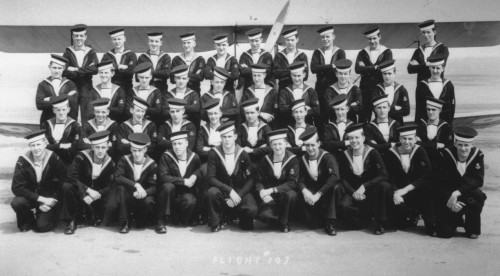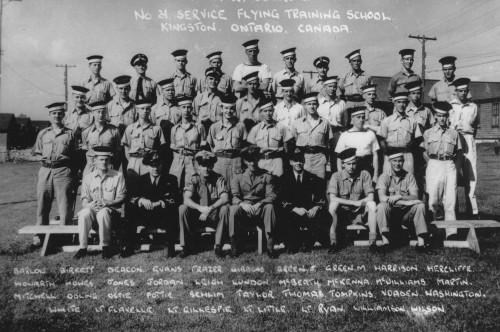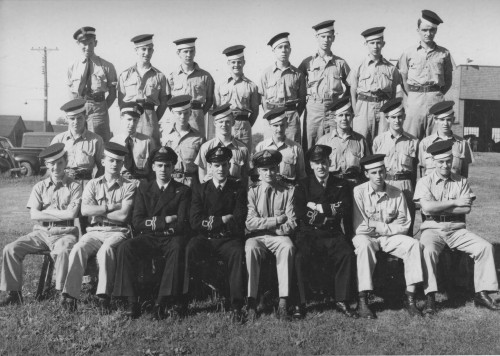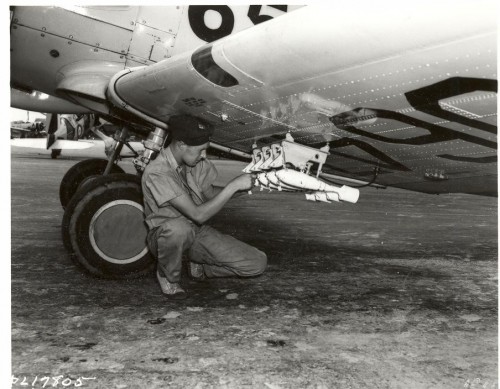On 12 January 1944, the Cabinet had approved manning two escort carriers with Canadian ships’ companies. Under the headline: “Canadian Fleet Air Arm Training Here,” it was reported on 22 August 1944 that a group of R.C.N.V.R. officers were being trained as pilots to serve in a future Canadian Fleet Air Arm. The present group of thirty-one officers in training were the first to be trained “with a view of eventual service in Canadian aircraft.”
The first four members of the R.C.N.V.R. to graduate as pilots directly into the R.C.N.V.R. received their wings on 6 October 1944. Among them was: Lieut.J.B. Grinnel, 23, of Kingston, former officer on the H.M.C.S. Alberni when she took part in the North African landings of 1942. Also graduating were: Lieut. Hugh J. (Rick) Ritchie, 22, of Vancouver, formerly on convoy duty with the escort ship, “La Mai Baie” on Atlantic convoy; and Lieut. Victor J. Wilgress, son of Canada’s ambassador to Moscow, who served on the Atlantic before joining the air arm.
Nearly 500 R.C.N. officers volunteered following the “let-up” in German submarine warfare in the Atlantic. The graduation of these first four pilots was such an important one in Canadian history that photographers from the Navy, Air Force, and the National Film Board were on hand to record it for posterity.
Others who graduated in Course 109 on October 6 were:
Lieuts. *A. W. Watson, Wilts.; P. S. Wilson, Bantham; A/POs: K. A. Barber, Burney; C. W. Davies, N. Wales; J. A. Goddard, Harrow; *R. D. Grummitt, Brighton; *B. W. Hewitt, Staffordshire; B. J. Jones, S. Wales; D. A. Jones, Bristol; E. Jones, N. Wales; B. McDonald, Essex; R. I. Marx, Surrey; A. P. Mollett, Birmingham; D. V. Mountain, Dorset; F. R. Murray, Liverpool; J. Orr, Scotland; P. E. Parker, Southorpe; J. R. Parr, Dagenham; J. C. Parry, Yorkshire; L. A. Patten, London; N. A. Peniston-Bird, Felixstowe; S. R. Percival,Newcastle-on-Tyne; C. B. Ratcliffe, Leeds; D. A. Ray, Wolverhampton; P. L. Reeves, Devon; H. C. Reid, Edinburgh; C. O. Richards, Manchester; R. Roberts, Prescott; C. E. Rolfe, London; L. D. Searson, Huntingdonshire; R. E. Sedgwick, Seffron Waldon; S. P. Smith, Cleethorpes; *W. E. Snaith, Northumberland; J. A. Snodgrass, Scotland; L. A. Stratton, Combwich; D. W. Sugden, Cornwall; *J. H. Sutton, Norwich; R. H. Tasker, Lancashire; F. A. Thompson, Belfast; F. E. Traylor, Scotland; R. Turpin, Southampton; D. F. Vallis, Somerset; E. C. Warrell, Ayrshire. (* see In Memoriam)
R.C.A.F. Group Captain W. R. Pollock assumed command of the station on August 17, replacing Group Captain C. F. LePoer Trench. The transfer from R.A.F. to R.C.A.F. was in place. The R.A.F. maintenance crew left and sixteen new Harvards arrived along with sixteen instructors, among them a former organist at Westminster Abbey.
R.C.A.F. Staff institute changes
Some changes began to be made at the station to accommodate the differences between the two groups. A former R.C.A.F. instructor remarked on the tea-drinking habits of the R.A.F.: “They would go to the mess for tea in the middle of the afternoon and not return to duties till nearly 5 p.m. Dinner was served at 8 p.m. which meant it was too late for the airmen to go into town, causing much
grumbling among the men. The R.C.A.F. staff soon put an end to that and dinner was thenceforth served sharply at 5 p.m.”
The R.C.A.F. also inaugurated a policy of training longer hours each day in order to have a 96-hour pass instead of the usual 48-hour.
To prepare the pupils for their post-graduate training in the U.K., the R.C.A.F. marked off 1000 feet of runway and began practicing simulated aircraft carrier landings.
The Gananoque Reporter , August 31, 1944
Appreciate Services Canteen
To the Editor:-
As one of the Royal Air Force who has been stationed at Gananoque for quite some time, I would like, before I leave this community to thank the people for all they have done for us.
I returned from leave a short while ago, and as the bus brought me through the gates of Gan, I had that feeling of “coming home.” I am many miles away from my English home, but it was a homely feeling to have. I felt good to be back! I went to the “Service Canteen,” and there, as always, I received a genuine welcome, a good cup of tea and “home-made” sandwiches. Yes, it felt good to be back.
I idly looked through the visitors’ book and read names and appreciation from the four corners of the world. Mr. Churchill would have said – “Come ye from the four corners of the world and meet at Gan.”
Mrs. Bird, Marnie Davis, Mrs. Sampson, Mrs. Henne, Mrs. Armstrong, Mrs. Edwards, Miss Mudie and all the other countless hostesses have something to be proud of in the tireless work they have done for us lads, at the “Canteen.” We are proud of them.
In the future, when I am home and the war is won, one day I shall build a house, firm and strong, and call it “Gananoque.” Then in the years to come, in a quiet spot in Yorkshire, England, these happy days will be recalled by all who ask about the name. I shall tell them of the great people I met in Gananoque in Canada.
So on behalf of the boys and myself, we thank you.
AIRMAN
(The Armed Services Canteen was in the building which, after the war, became the home of the Col. Russel H. Britton Branch 92 of the Royal Canadian Legion. Unfortunately, the guest book that had been signed throughout the years by men from all over Canada, the United Kingdom, and other Commonwealth Countries cannot be found.)
On October 20, thirty-nine members of the F.A.A. received wings at No. 14 S.F.T.S. Included in the class were:
Lieuts. D. W. Knox, Quebec; J. B. Fotheringham, Toronto; N. A. Jones, Vancouver, B.C., D. W. Knox, Quebec. Also graduating were: J. Abel, Essex; W. J. Adams, Bristol; F. A. Allen, Sheffield; A. J. Andrews, Essex; J. H. Bailey, Sussex; L. R. Bailey, Sussex; K. A. Carter, Kent; M. G. Champion, Gloucestershire; B. Clark, Canterbury; P. G. Cowan, Liverpool; G. Crichton, Cumberland; F. Dunn, Cheshire; A. L. Ford, Wales; J. R. Gilbert, Hampshire; F. G. Hart, Manchester; J. D. Hobbs, Surrey; E. J. Hoy, S. Africa; B. H. Jacombs, Birmingham; P. Jones, Leeds; D. W. Langley, Middlesex.; D. MacLeod, London; D. E. Marshall, Sussex; J. D. McDonald, Scotland; J. Narey, Yorkshire; O. B. Norwood, Oxford; K. O’Doherty, Devon; W. A. Owen, Bedfordshire; R. E. Read, London; *A. L. Robertson, Angus, Scotland; R. H. Spackman, Wiltshire; A. Taiter, Middlesex; R. P. Underwood, Kent; E. B. D. Ward, Oxford; E. G. Ward, Kent; M. S. Williams, Kent; J. S. Wyatt, Scotland. [*see In Memoriam]
A/LA Sydney Garbutt who was killed on August 16 at Gananoque arrived with this group.
On November 3, thirty-seven student pilots of Course 111 graduated at a wings parade. Commander J. S. Stead, R.C.N., pinned on the wings during the ceremony, accompanied by Lt. Cmdr. H. J. Gibbs. Included were four lieutenants of the R.C.N.V.R. who had volunteered with the Fleet Air Arm. They were: J. J. Fenney, Westmount, Quebec; K. K. Field, Edmonton, Alberta; F. K. Heap, Winnipeg, Manitoba; and D. C. M. Smith, St. Lambert, Quebec.
Also graduating were: Lieuts. R. C. Pearson; H. Phillips; APOs W. P. Baldwin; K. V. Breed; D. P. Burke; J. W. Byres; A. K. Carter; A. Q. Clarke; J. Cole; C. E. Deacon; J. B. Dickins; T. C. Evans; H. J. Gibbs; W. C. Haggo; M. J. Hedges; S. A. Holdaway; G. C. Hounslow; D. E. Ironside; K. J. James; W. A. Jones; E. Marsden; M. W. Matthews; D. A. McNaughton; G. A. Mitchell; F. E. Nelson; D. J. Parker; D. H. Robertson; O. B. Silver; R. D. Walkley; *D. West; J. W. Wickham; W. J. Woodhouse; W. B. Youngman. [*see In Memoriam)
The photo below was taken at #12 E.F.T.S. Goderich, Ont. A few names are: Back left: Wickham, King, unkn, Lunden, N.Z., unkn, Ostle, Marsden, Jones, Saveage, McNeil, Canada; 3rd row L-R Silver, *West, Deacon, unkn, unkn, Odling, unkn, Schlim, Belgium. 2nd row L-R McEwan, Canada, Martin, unkn, Stevenson, unkn, unkn, Pottle, Harrison, Canada, McNaughton; Front Row: McBeath, N.Z., Gibbons, N.Z., Washington, Canadian; Tompkins, Ironside, unkn, unkn, Humphreys, unkn, White, N.Z.
Unidentified: Street, Price, Nelson, Osborne, Hayward, Parnall, Francis, Matthews, Wheelwright, Youngman. Four names still missing. (Thanks to Bill Martin for photos.)

Centre of front row is D. E. Ironside; 2nd from L second row is Bill Martin
A/LA F. J. Shadbolt, R.N.Z.N.
November 17, 1944
A/LA Frederick John Shadbolt, age 21, died when his Harvard crashed on the farm of Eldon Bennett, Inverary, on November 17. The plane lost altitude, struck several trees breaking off pieces of the wing, continued for about three-quarters of a mile before slashing through several trees, and finally crashed in a pasture. He was the son of Frederick John and Beryl O. Hinemoa Shadbolt of Picton, Marlborough, N. Z.
On that day, four members of the RCNVR graduated: Lieuts. W. E. Flavelle, Vancouver; D. P. Ryan, Montreal; *H. M. Little, Montreal; and A. W. Gillespie, Victoria. (*see In Memoriam) Graduating as an Acting Petty Officer was L. A. Washington of Hamilton. Other members of the class were:
P. Barlow, Cheshire; A. I. Deacon, Leicester; A. J. Evans, N. Ireland; R. C. Gibbons, N.Z.; J. W. Green, Lancashire; M. Green, Yorkshire; J. A. Harrison, Gloucestershire; F. Hercliffe, Lancashire; R. Howarth, Glasgow; A. R. Howes, Oxford; C. G. Jones, Liverpool; F. F. Jordan, Surrey; H. Leigh, Shrewsbury; W. A. Martin, Bristol; J. McKenna, Middlesex; G. McWilliams, Cumberland; A. Q. Mitchell, Bournesmith; A.G. Odling, Cheshire; H. Ostle, Cumberland; A. J. Schlim, Belgium; P. J. Thomas, Hertfordshire; S. Tomkins, Lancashire; N. C. Voaden, Lancashire; M. H. White, N. Z., J. R. Williamson, Glasgow; E. R. Wilson, London.

Announcement – November 17, 1944
Commonwealth Air Plan Ends.
Power Sets Closing Date as March 31.
Local Station is Unaffected as it is Not Operating Under the B.C.A.T.P.
[C. G. Power was Minister of National Defense for Air]
The shortest graduation ceremony was held on December 1 with thirteen F.A.A. and two R.C.N.V.R. successfully completing the course. The Canadians were:
Lieut. W. F. Patrick, Winnipeg, and *Lieut. F. W. McGarry, Toronto.
The F.A.A. were: R. Adams, Wembley; A/PO G. G. Aitchison, Glasgow, Admiralty prize winner; *E. T. Alwood, Rochford; J. H. Birkett, Mansfield; John H. Cronin, Highbury; T. G. Hawkins, Caterham; W. Dawson, Bolton; A. Hare, Airdrie, Scotland; A. E. Harrison, Southport; P. J. Menhenitt, Wadebridge; R. T. Pope, Napier, N.Z.; B. R. Turner, Reading; A. G. Wain, N. Wingfield. [*see In Memoriam]

Photo of Course 114 was taken in August 1944; they graduated in December 1944.
L to R Back row: RM. I. M. Calvert, Belper, Derbyshire; APO’s D. J. Elliott, St.Ives, Cornwall; F. Garwood, Manchester; A. T. Hale, Andover, Hants; Admiralty prize winner G. R. Higgs, Bristol; P. Howell, Birmingham; G. Jeffery, Watford, Hertfordshire; F. W. Keatley Coventry; E. Lewis, Manchester; CPO W. MacKay, Whitley Bay; K. W. Mitchell, Bradford, Yorkshire; N. A. Mumberson, Carlisle; D. S. Nice, Waterbeach, Cambs; H. E. Osborn, Grays, Essex; A. T. Oxford, Sherborne, Dorset; D. A. Parkins, Croyden; G. J. Prentice, Grays, Essex; J. H. Summerlee, Huntingdon, Huntingdonshire; Lt. F. J. Hayes, RCNVR, Montreal; Lt. G. D. Campbell, RCNVR Toronto; Lt. W. H. Thompson RCNVR Regina; Lt. N. C. Norris, RCNVR, Regina; *K.C.N. Travis, Wilmslow, Chesh.; E. W. Turner, Glasgow. (*see In Memoriam)
Also graduating with the course were the following pupils who were unable to graduate with their own due to illness or injuries. They were: D. E. W. Aldous, Barking, Essex; P. J. Evans, Brighton; M. J. G. Kirby, Evington, Leicester; J. Richards, Helston, Cornwell; R. H. Taylor, Farnham, Surrey.
Again in December, the newspapers reported that the area was hit by the worst snowstorm in years. One of the several pilots who had been lost in fog or snow had been forced to land in different areas of northern New York State was F/O Douglas Wagner, R.A.F. instructor. Flying with student A/LA Richard Earl, he became lost in a blinding snowstorm and landed their Harvard aircraft near Sackets Harbor. F/O Wagner said that he climbed to 10,000 feet without emerging from the snow, then dived the plane through a hole in the storm and landed with the wheels of the plane up.
At a graduation ceremony on 19 January 1945, twenty-three commissioned officers and acting petty officers received their wings from Commander C. Oliver Foley, OBE, R.N., senior naval officer at the station, while two had their wings pinned on by their mothers. Among the Canadians graduating were: Lieuts. G. L. Ollson, Regina; J. R. Dean, Toronto; C. D. Richardson, Sarnia,, Westminster, B.C. and E. S. Kirkland, Perth, and Acting Petty Officer F. J. Dayton.
Also graduating were: Lieut. H. Hunt, England; A/POs J. Bailey, Yorkshire; D. R. Broadhurst, Middlesex; B. H. Browne, N.Z.;; H. A. Dougall, Argentina; A. Eccleston, Lancashire; C. I. Emson, Essex; R. Field, Kent; S. J. Garner, Buckinghamshire; J. Hawkins, Derby; J. C. Heathcote; H. J. Morley, Glasgow; J. Partington, Manchester; T. S. Peace, Worcestershire.; M. F. Romeril, Birmingham; G. Stephen, Scotland; T. A. Tallon, Leicester; N. D. Thatcher, Kent; J. F. Toolan, Norfolk; and N. T. Willetts, Birmingham.
The British government asked to have 100 pilots accepted every two weeks for training in Canadian schools. This programme began immediately and continued under the B.C.A.T.P. until 31 March 1945 when a new Anglo-Canadian agreement came into effect, which continued R.A.F./F.A.A. flying training in Canada on a much reduced scale until the end of the war against Japan. This last agreement was entirely separate from the B.C.A.T.P.
The meterological station at No. 14 reported a further snowfall on January 3, bringing the total to 43-1/2 inches. On the 12th, another blizzard struck and it was reported that in some areas of Leeds it had been two weeks since transportation could be made by automobile. “The familiar sounds of sleighbells have been heard throughout the town as the male rural residents have been coming to town with horses and sleigh to procure provisions.”
BOMBING PRACTICE AT KINGSTON MILLS RANGE
Former instructor Doug Wagner described the advanced training section bombing practice: “We had two bombing ranges, one at Millhaven and one at Kingston Mills. In the summertime, when these bombs were dropped on the target, they made a big splash if they went in the mud, and if they hit the target they would explode. During the winter months we were dropping about 400 of these things a day so this represented quite a few tons of steel, and when the head blew off you had about four pounds in the nose and these became quite a salvageable item.” The locals would run out on the ice to collect a few to sell, so one day he couldn’t resist playing a joke: “I was flying on the last detail with a pupil and we dropped our eight bombs and, being in the last detail, my job was to lower the wheels and fly over the hut and advise the range officer so he could pull the flag down and go home. Then we raised the under-carriage and started to fly back towards the airport, when on looking back I saw all these boys scampering to the target area. I said to my pupil, ‘Let’s have some fun. We turned around, went back up to height again, and came back as if we were another detail and then started to dive. You should have seen the fun. There were fellows running, getting down flat on the ice, some pulling the sleds over top of them, some standing and waving at us. There was one terrific panic!”

R.C.A.F. photo
The student pilots were officers-in-training and the ground crew had to treat them with the respect due them. Sgt. Bill Burt, R.C.A.F., had been transferred to No. 14 S.F.T.S. and shortly afterwards was posted to Gananoque and put in charge of a bomb hut. He recalled an incident that made him forget that regulation:
“The practice bombs were 11-1/2 lb. smoke bombs with a small charge of TNT in the nose and were loaded four under each wing. This one day I had just loaded them when the pupil accidentally jettisoned all eight after the bombs had been activated. Due to the height of the wing, the bombs dropped on their sides and not on the nose. Otherwise, the explosion would have killed both of us.”
He said he reacted instantly and leapt onto the wing and began to give the startled pupil a severe tongue-lashing, only just restraining himself from strangling him. For this, he received 14 days’ confined to camp. What bothered him most, he said, was that he had just begun dating a beautiful young lady in town and couldn’t get in touch with her. They married and this young man from a dirty steel town on Cape Breton Island was very happy to make Gananoque his home.
Next Chapter: 27. Training Continues As New Year Begins
Previous Chapter: 25. The First Of The Tranferred R.C.A.F. Personnel Arrive